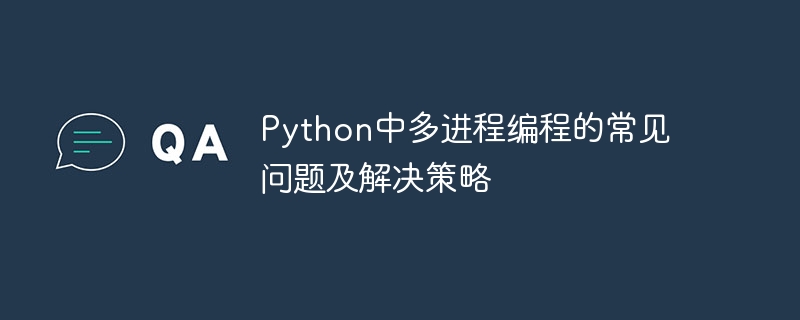

Common problems and solution strategies for multi-process programming in Python
Introduction:
With the continuous development of computer hardware, multi-core processors have become more and more more common. In order to make full use of hardware resources and improve program execution efficiency, multi-process programming has become an important technology. But when using multi-process programming, we often encounter some problems, such as inter-process communication, resource synchronization, etc. This article will introduce common problems with multi-process programming in Python, and provide solution strategies and specific code examples.
Question 1: Inter-process communication
Communication between multiple processes is a common problem. In Python's multiprocessing module, a variety of inter-process communication methods are provided, such as pipes (Pipe), queues (Queue) and shared memory (Value, Array). The following is a sample code that uses pipes for inter-process communication:
from multiprocessing import Process, Pipe
def send_data(conn):
data = [1, 2, 3, 4, 5]
conn.send(data)
conn.close()
def receive_data(conn):
data = conn.recv()
print(data)
conn.close()
if __name__ == '__main__':
parent_conn, child_conn = Pipe()
p1 = Process(target=send_data, args=(child_conn,))
p2 = Process(target=receive_data, args=(parent_conn,))
p1.start()
p2.start()
p1.join()
p2.join()In the above code, we create two processes, one process sends data through the pipe, and the other process receives data through the pipe. When communicating between processes, we need to pay attention to the bidirectionality of pipes. Both the parent process and the child process can perform read and write operations, so the sender and receiver of data need to be determined based on actual needs.
Question 2: Process synchronization
Another common problem in multi-process programming is process synchronization. In some cases, we need to ensure that multiple processes execute in a certain order. Python's multiprocessing module provides a variety of process synchronization methods, such as lock, semaphore and event. The following code example shows how to use locks to achieve process synchronization:
from multiprocessing import Process, Lock
def func(lock, counter):
lock.acquire()
try:
for i in range(5):
counter.value += 1
print(counter.value)
finally:
lock.release()
if __name__ == '__main__':
lock = Lock()
counter = Value('i', 0)
processes = []
for i in range(2):
p = Process(target=func, args=(lock, counter))
processes.append(p)
p.start()
for p in processes:
p.join()In the above code, we create a lock object and pass it to two processes. In this way, during process execution, only one process can obtain the lock object, and other processes will wait. This ensures that multiple processes are executed in a certain order.
Question 3: Exception handling in multi-process
In multi-process programming, exception handling is an important issue. If an exception occurs in a process and is not handled, other processes may continue to execute, causing program errors. In order to avoid this situation, we can add exception handling code to each child process and print out the exception. The following example shows how to catch exceptions in multiple processes and print them:
from multiprocessing import Process
def func():
try:
# 子进程需要执行的代码
print('子进程执行')
raise Exception('子进程异常')
except Exception as e:
# 打印异常
print(e)
if __name__ == '__main__':
p = Process(target=func)
p.start()
p.join()In this example, we threw an exception in the child process and handled the exception in the except code block. In this way, even if an exception occurs in the child process, the main process can receive the exception information and handle it in time.
Conclusion:
Multi-process programming in Python provides a large number of tools and methods to help us make full use of hardware resources and improve the execution efficiency of the program. When using multi-process programming, we need to pay attention to issues such as inter-process communication, process synchronization, and exception handling, and use appropriate methods and strategies to solve them. I hope this article can help everyone better understand multi-process programming and successfully apply it to actual projects.
The above is the detailed content of Common problems and solution strategies for multi-process programming in Python. For more information, please follow other related articles on the PHP Chinese website!




